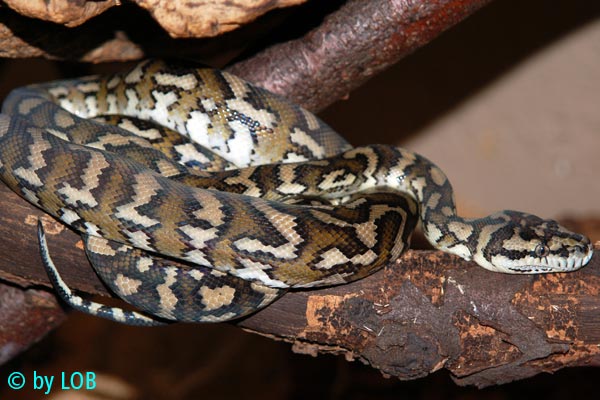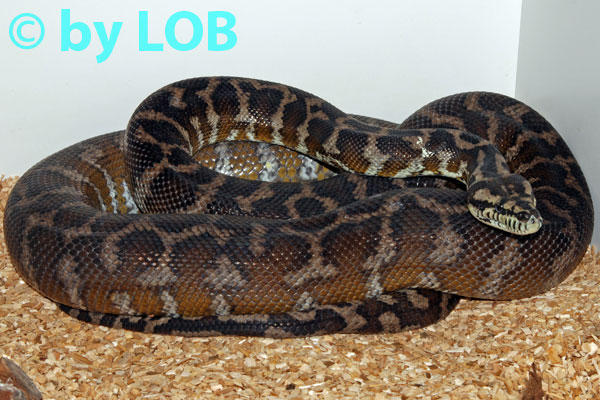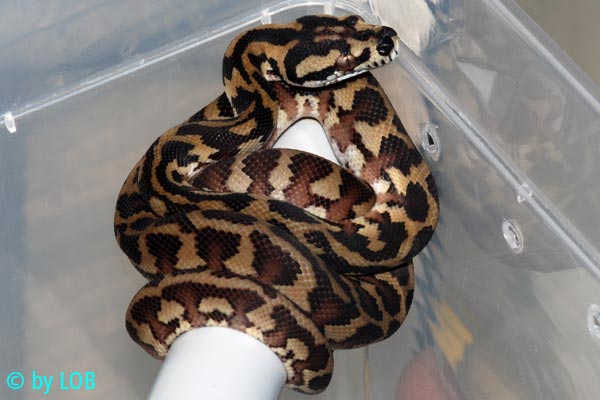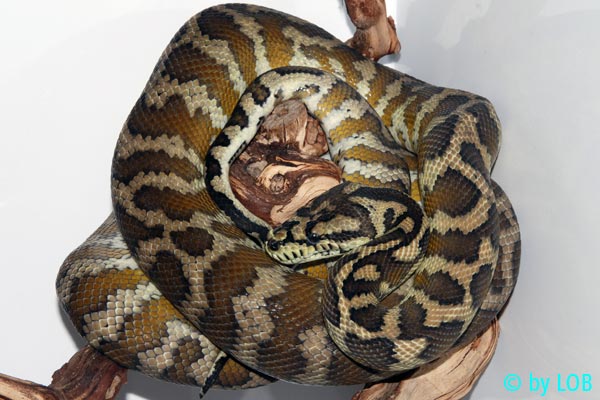
Morelia harrisoni – HOSER, 2000
(Morelia variegata / Morelia spilota harrisoni)
(Morelia variegata / Morelia spilota harrisoni)

Morelia harrisoni: Adult captive-bred male • Adultes Nachzuchtmännchen
© Lutz Obelgönner
© Lutz Obelgönner

Morelia harrisoni: Adult gravid captive-bred female • Adultes trächtiges Nachzuchtweibchen
© Lutz Obelgönner
© Lutz Obelgönner
New Guinea Carpet Python
Description
Non-venomous. Named to honour the Australian aviculturist David Harrison who played a pivotal role in exposing corruption and misconduct in Australian wildlife departments. Species was separated from the Morelia spilota group by Raymond Hoser, who had an essential impact on the same matter. Mense regrouped it with Morelia spilota again. One of the smaller species of the complex, the only carpet python living outside of Australia. Less arboreal than related species. Once started hatchlings are good pythons for beginners.
Protection
EU Directive 338/97, Appendix B
Adult Size
160–200 cm
Lifespan
more than ten years
Distribution
southern New Guinea and Irian Jaya
Habitat
semi-humid biotopes, sclerophyll and rain forests
Captive Care
Species is easy to keep and breed. Cage at least 150x70x70 cm WDH. Keep adults semi-dry, hatchlings need more humidity. Climbing branches and/or elevated shelves, retreats (e. g. bird nesting box), water bowl. Day temperature 26–28 °C, local spot 35 °C e.g. by using wall or top heating system, night temperature 22–24 °C, humidity 60–70 %. Fluorescent lamps, loose and absorbent substrate. Hatchlings should be reared individually in rack systems.
Food
rodents, birds
Reproduction and Rearing
Pairs possible, they need a cooler period (two months at 22 °C) to stimulate mating. 5–20 eggs in a clutch, incubate at 29 °C for 60–65 days. Some hatchlings require force feeding. Hatchling can be reared in a rack system to ease feeding, control, and maintenance.
Non-venomous. Named to honour the Australian aviculturist David Harrison who played a pivotal role in exposing corruption and misconduct in Australian wildlife departments. Species was separated from the Morelia spilota group by Raymond Hoser, who had an essential impact on the same matter. Mense regrouped it with Morelia spilota again. One of the smaller species of the complex, the only carpet python living outside of Australia. Less arboreal than related species. Once started hatchlings are good pythons for beginners.
Protection
EU Directive 338/97, Appendix B
Adult Size
160–200 cm
Lifespan
more than ten years
Distribution
southern New Guinea and Irian Jaya
Habitat
semi-humid biotopes, sclerophyll and rain forests
Captive Care
Species is easy to keep and breed. Cage at least 150x70x70 cm WDH. Keep adults semi-dry, hatchlings need more humidity. Climbing branches and/or elevated shelves, retreats (e. g. bird nesting box), water bowl. Day temperature 26–28 °C, local spot 35 °C e.g. by using wall or top heating system, night temperature 22–24 °C, humidity 60–70 %. Fluorescent lamps, loose and absorbent substrate. Hatchlings should be reared individually in rack systems.
Food
rodents, birds
Reproduction and Rearing
Pairs possible, they need a cooler period (two months at 22 °C) to stimulate mating. 5–20 eggs in a clutch, incubate at 29 °C for 60–65 days. Some hatchlings require force feeding. Hatchling can be reared in a rack system to ease feeding, control, and maintenance.
Neu-Guinea-Rautenpython
Generelles
Ungiftig. Benannt zu Ehren des australischen Vogelzüchters David Harrison, der maßgeblich zur Aufdeckung von Korruption und Betrug in australischen Wildtierbehörden beigetragen hat. Hoser, selbst auf diesem Gebiet sehr engagiert, hat die Art vom Morelia-spilota-Komplex abgespalten, Mense hat die Form wieder als Unterart eingeordnet. Eine der kleinsten Arten der Gruppe, weniger arboreal als andere. Der einzige außerhalb Australiens vorkommende Rautenpython. Eingewöhnte NZ sind gut geeignete Tiere für Pythonanfänger.
Schutzstatus
EU-Verordnung 338/97, Anhang B
Größe
160–200 cm
Lebenserwartung
mehr als zehn Jahre
Vorkommen
südliches Neu-Guinea und Irian Jaya
Habitat
halbfeuchte Biotope, Trockenwald, Regenwald
Haltung
Die Art ist einfach zu halten und zu züchten. Terrarium mind. 150x70x70 cm BTH. Adulti halbtrocken halten, Jungtiere brauchen mehr Feuchtigkeit. Kletteräste und/oder erhöhte Ablage, Versteckplätze (z. B. Vogelnistbox), Wasserbecken. Tagestemperatur 26–28 °C, lokale Erwärmung auf 35 °C, nachts 22–24 °C, Luftfeuchtigkeit 60–70 %. Leuchtstoffröhren, Bodengrund z. B. harzfreies Holzgranulat oder anderes lockeres, saugfähiges Substrat. Jungtiere sollten einzeln (Racks) aufgezogen werden.
Futter
Nager, Vögel
Zucht und Aufzucht
Paar- oder Einzelhaltung sinnvoll, 2 Monate kühlere Phase bei etwa 22 °C als Paarungsauslöser. 5–20 Eier, Schlupf nach 60–65 Tagen bei 29 °C. Einige Jungtiere (40 cm) müssen gestopft werden, manche entwickeln sich zu Futterspezialisten. Aufzucht am besten einzeln im Racksystem, um Fütterung, Kontrolle und Wartung zu vereinfachen.
Ungiftig. Benannt zu Ehren des australischen Vogelzüchters David Harrison, der maßgeblich zur Aufdeckung von Korruption und Betrug in australischen Wildtierbehörden beigetragen hat. Hoser, selbst auf diesem Gebiet sehr engagiert, hat die Art vom Morelia-spilota-Komplex abgespalten, Mense hat die Form wieder als Unterart eingeordnet. Eine der kleinsten Arten der Gruppe, weniger arboreal als andere. Der einzige außerhalb Australiens vorkommende Rautenpython. Eingewöhnte NZ sind gut geeignete Tiere für Pythonanfänger.
Schutzstatus
EU-Verordnung 338/97, Anhang B
Größe
160–200 cm
Lebenserwartung
mehr als zehn Jahre
Vorkommen
südliches Neu-Guinea und Irian Jaya
Habitat
halbfeuchte Biotope, Trockenwald, Regenwald
Haltung
Die Art ist einfach zu halten und zu züchten. Terrarium mind. 150x70x70 cm BTH. Adulti halbtrocken halten, Jungtiere brauchen mehr Feuchtigkeit. Kletteräste und/oder erhöhte Ablage, Versteckplätze (z. B. Vogelnistbox), Wasserbecken. Tagestemperatur 26–28 °C, lokale Erwärmung auf 35 °C, nachts 22–24 °C, Luftfeuchtigkeit 60–70 %. Leuchtstoffröhren, Bodengrund z. B. harzfreies Holzgranulat oder anderes lockeres, saugfähiges Substrat. Jungtiere sollten einzeln (Racks) aufgezogen werden.
Futter
Nager, Vögel
Zucht und Aufzucht
Paar- oder Einzelhaltung sinnvoll, 2 Monate kühlere Phase bei etwa 22 °C als Paarungsauslöser. 5–20 Eier, Schlupf nach 60–65 Tagen bei 29 °C. Einige Jungtiere (40 cm) müssen gestopft werden, manche entwickeln sich zu Futterspezialisten. Aufzucht am besten einzeln im Racksystem, um Fütterung, Kontrolle und Wartung zu vereinfachen.
Literature / Literatur
Hoser, Raymond (2000). A revision of the Australasian pythons (descriptions of Antaresia (Liasis) saxacola campbelli and others). Ophidia Review 1: 7–27.
(www.smuggled.com/pytrev1.htm)
Mense, Marc (2015). Carpet pythons – Morelia bredli, Morelia carinata and the Morelia spilota complex. NTV, Münster.
Mense, Marc (2015). Rautenpythons – Morelia bredli, Morelia carinata und der Morelia-spilota-Komplex, 2. Auflage. NTV, Münster.
Hoser, Raymond (2000). A revision of the Australasian pythons (descriptions of Antaresia (Liasis) saxacola campbelli and others). Ophidia Review 1: 7–27.
(www.smuggled.com/pytrev1.htm)
Mense, Marc (2015). Carpet pythons – Morelia bredli, Morelia carinata and the Morelia spilota complex. NTV, Münster.
Mense, Marc (2015). Rautenpythons – Morelia bredli, Morelia carinata und der Morelia-spilota-Komplex, 2. Auflage. NTV, Münster.

Morelia harrisoni: Juveniles can ideally be raised individually in plastic boxes placed in a rack system • Nachzuchttiere können zur Aufzucht gut einzeln in Plastikboxen in einem Rack-System gehalten werden.
© Lutz Obelgönner
© Lutz Obelgönner

Morelia harrisoni: Colourful adult captive-bred male • Farbkräftig gezeichnetes adultes Nachzuchtmännchen
© Lutz Obelgönner
© Lutz Obelgönner